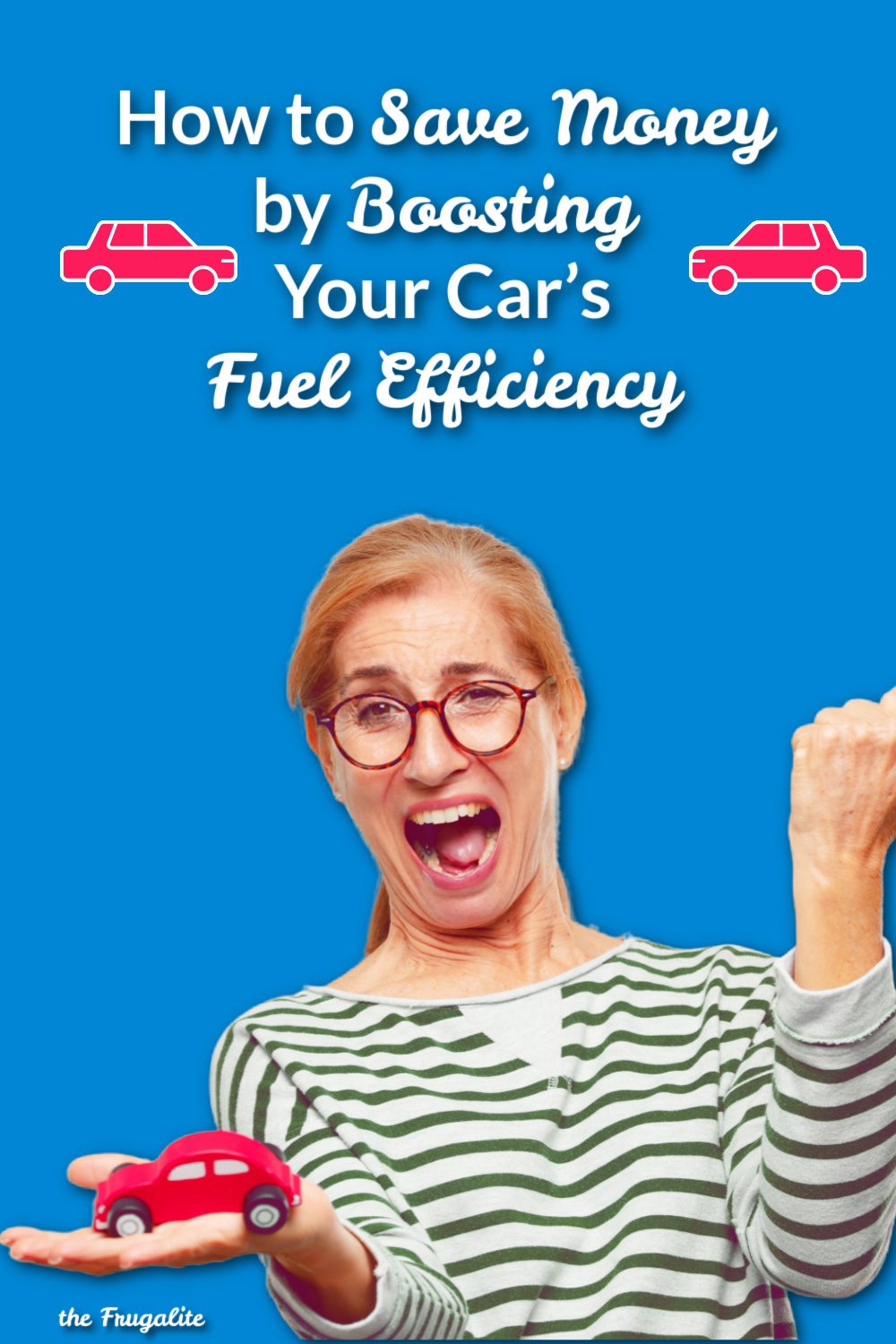(Psst: The FTC wants me to remind you that this website contains affiliate links. That means if you make a purchase from a link you click on, I might receive a small commission. This does not increase the price you’ll pay for that item nor does it decrease the awesomeness of the item. ~ Daisy)
It seems that rapidly rising inflation is here to stay. One of the key ways to deal with this is to figure out ways to cut back on your expenses as much as possible. And a fantastic way to do THAT is to improve your car’s fuel efficiency.
Here are a couple of tips which will help you to drive like a Frugalite master.
Don’t drive aggressively.
Interestingly, those who drive like idiots really aren’t doing themselves any favors. Aside from drastically increasing their chances of getting into an accident or killing a pedestrian, these people also pay more to drive in the form of more frequent gasoline purchases.
And all this for arriving an average of two minutes sooner compared to the individual who decided to drive like a rational person.
On the highway, this aggressive driving can actually cost you 15-20% of your fuel efficiency. And if you’re driving through the middle of rush hour in the city, this fuel efficiency cost for the aggressive driver can spike to a 10-40% loss.
We’ll assume most Frugalite readers drive little cars (I’m painting with a broad brush, I know). Let’s say you normally get 30mpg.
This would mean aggressive driving on a highway could cause you to actually get 26mpg. In that rush hour, city traffic? Your fuel efficiency could drop down to 18mpg.
Unless you want to get the gas mileage of a pickup truck, we recommend driving your car like you didn’t steal it.
Improve your car’s aerodynamics
If you drive a truck, drop your tailgate as you drive (provided you’re not carting stuff around). If you’re driving around town, take your cartop carrier off. Both of these increase the wind resistance of your vehicle, and this means your engine has to work harder to get from Point A to Point B.
The harder your engine has to work, the lower your fuel efficiency. On the interstate, this means your fuel efficiency can drop somewhere in the ballpark of 10-25%.
Again, let’s turn to our 30mpg little green car. If you strap a kayak to the roof, you could very well be looking at 22.5mpg instead. That makes your little “free” trip to the lake that much more expensive.
Understand your AC costs gas.
Obviously, if you live in the middle of Texas, you need to run your air conditioning. It’s better to spend a little extra money on gas and arrive at your destination than it is to pass out from overheating and show up at an operating room instead.
That being said, there are most certainly times where one can skimp on the AC within their car. And this can actually save you money as well. In hot weather, running your AC can actually cause your fuel economy to drop by up to 25+%.
So in our little green 30mpg car with the banged up bumper, that means your fuel efficiency could once more drop to 22.5mpg. The catch here is that if you resort to rolling down your windows, you increase the wind resistance of your vehicle, burning more gas.
The happy balance here is typically to roll your windows down when driving slower, and use your AC when you’re driving down a highway, interstate, or down some other road which has a high speed limit. This will better keep you cool, save money, and keep your car safe from overheating as well.
50mph is the magic number.
There’s some speculation here as to why, but 50mph is the magic number for gas mileage. Once you go above that number, your fuel efficiency begins to wane. In fact, for every 5mph over that magic number you go, you’ll lose an average of $0.23/gallon for gas.
So, let’s say you have a full day of running errands through town (50 miles total). The average speed limit where you live is 50mph.
If you decide to go 60mph for that full day of errands, you’ll have spent an additional $0.46/gallon due to decreased fuel efficiency.
If it normally costs you $3.00/gallon for gas, you’ve essentially bumped up that number to $3.46/gallon. And if you have to fill a 15-gallon tank, that means you just spent an additional $6.90. If you’re doing this five days a week (e.g. running kids to school, football games, and band practice), you’re spending an extra $34.50/week you wouldn’t need to.
Over the course of a month, you’re looking an approximate $138 extra spent on gasoline.
Cold weather decreases your gas efficiency.
There’s only so much you can do about this, but if the weather outside is frigid, you’re going to be spending more per gallon in gas. The reason for this is that cold air is denser than warm air. This means that the wind resistance your car experiences as you’re driving down the road is going to be greater.
How bad is this though?
Driving in 20-degree weather (in American Fahrenheit, dang it!) will actually cause your vehicle to be 15% less efficient than it would be in 77-degree weather.
Our little green car with a banged-up bumper and trunk full of PDF cook books (it’s filled with USB drives, ok?) would go from 30mpg in the 77-degree weather then to 26.5mpg in the 20-degree weather. Perhaps that’s not a huge deal for you – and after all, you have to do what you have to do – but if you’re really looking to save money, you may be able to do that by nixing unnecessary errands until later in the day.
Wind resistance alone isn’t the only culprit here, however. Cold weather means you have the heater on, which – surprise – decreases gas efficiency. Your engine takes a longer time to heat to it’s optimum fuel-efficient temperature as well.
Keep a few key parts up to speed.
Your spark plugs, oxygen sensor, and air filter all need to be in tip-top condition if you want to get the most bang for your gasoline-dollar. Of these three components, the oxygen sensor is the most important savings source.
A faulty oxygen sensor can actually decrease your fuel efficiency by up to 40%.
So our little green car with the banged-up bumper, trunk full of PDF cookbooks, and Betsy Ross bumper sticker would drop from 30mpg to 18mpg.
The more you save on the road, the more money you can put in the bank!
Or towards your mortgage, kid’s college fund, or whatever. What are your thoughts? Are there other ways to save money by improving your vehicle’s fuel efficiency that we didn’t cover above? Let us know in the comments below!
About Aden
Aden Tate is a regular contributor to TheOrganicPrepper.com and TheFrugalite.com. Aden runs a micro-farm where he raises dairy goats, a pig, honeybees, meat chickens, laying chickens, tomatoes, mushrooms, and greens. Aden has two published books, The Faithful Prepper and Zombie Choices. You can find his podcast The Last American on Preppers’ Broadcasting Network.












3 thoughts on “How to Save Money by Boosting Your Car’s Fuel Efficiency”
“50mph is the magic number.”
No it isn’t. Cars get their best mileage at peak load matching wind resistance. So, gearing makes a difference up to a point as well. That old “magic number” figure is from the 1980s, a time before CVTs or eight-speed transmissions. FYI, my magic number is 65mph.
The tailgate story is a myth. Most modern pickups are designed to get their best mileage with the tailgate closed.
Regarding best speed, Bill in Houston has it right.
In my little car, the sweet spot is 70. In my diesel truck, it’s around 65.
Of course if you run 50 on the interstate, there may be other problems.
Tire pressure makes a big difference, not to mention the safety hazard of underinflated tires.
Proper tire inflation as mentioned above but also alignment issues and any braking ones can greatly affect fuel economy.
Lighten vehicle load, we live off road and need about 200 lb of gear incase of mishaps.
Use good lubricants not only saves fuel but repair cost. Get oil checked for wear issues atleast once a year.
Proper tires for weather all season are good at nothing yeah it costs to have two sets but you save and have better performance in high stress situations like icey roads, water covering road, mud, gravel, oil after light rain. What is your life worth to you?